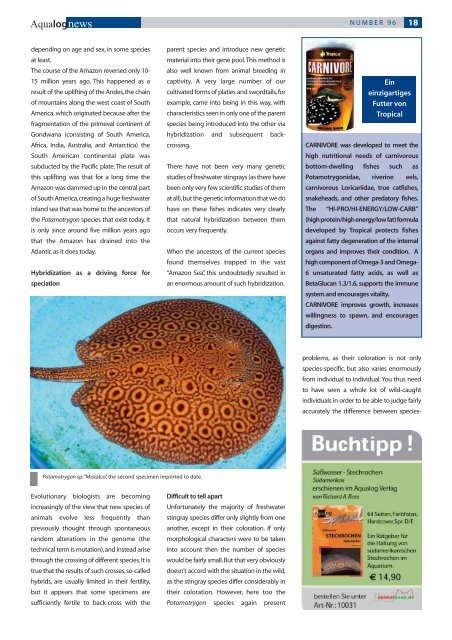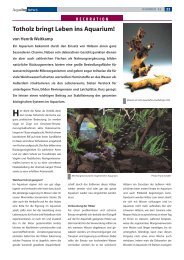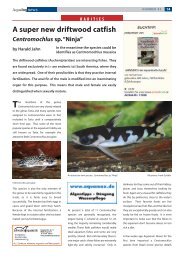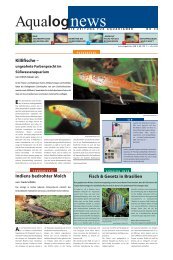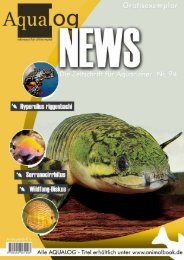Moenkhausia cosmops - Aqualog
Moenkhausia cosmops - Aqualog
Moenkhausia cosmops - Aqualog
Create successful ePaper yourself
Turn your PDF publications into a flip-book with our unique Google optimized e-Paper software.
<strong>Aqualog</strong>news NUMBER 96 18<br />
depending on age and sex, in some species<br />
at least.<br />
The course of the Amazon reversed only 10-<br />
15 million years ago. This happened as a<br />
result of the uplifting of the Andes, the chain<br />
of mountains along the west coast of South<br />
America, which originated because after the<br />
fragmentation of the primeval continent of<br />
Gondwana (consisting of South America,<br />
Africa, India, Australia,and Antarctica) the<br />
South American continental plate was<br />
subducted by the Pacific plate. The result of<br />
this uplifting was that for a long time the<br />
Amazon was dammed up in the central part<br />
of South America,creating a huge freshwater<br />
inland sea that was home to the ancestors of<br />
the Potamotrygon species that exist today. It<br />
is only since around five million years ago<br />
that the Amazon has drained into the<br />
Atlantic as it does today.<br />
Hybridization as a driving force for<br />
speciation<br />
Potamotrygon sp.“Mozaico”,the second specimen imported to date.<br />
Evolutionary biologists are becoming<br />
increasingly of the view that new species of<br />
animals evolve less frequently than<br />
previously thought through spontaneous<br />
random alterations in the genome (the<br />
technical term is mutation), and instead arise<br />
through the crossing of different species. It is<br />
true that the results of such crosses,so-called<br />
hybrids, are usually limited in their fertility,<br />
but it appears that some specimens are<br />
sufficiently fertile to back-cross with the<br />
parent species and introduce new genetic<br />
material into their gene pool.This method is<br />
also well known from animal breeding in<br />
captivity. A very large number of our<br />
cultivated forms of platies and swordtails, for<br />
example, came into being in this way, with<br />
characteristics seen in only one of the parent<br />
species being introduced into the other via<br />
hybridization and subsequent backcrossing.<br />
There have not been very many genetic<br />
studies of freshwater stingrays (as there have<br />
been only very few scientific studies of them<br />
at all),but the genetic information that we do<br />
have on these fishes indicates very clearly<br />
that natural hybridization between them<br />
occurs very frequently.<br />
When the ancestors of the current species<br />
found themselves trapped in the vast<br />
“Amazon Sea”, this undoubtedly resulted in<br />
an enormous amount of such hybridization.<br />
Difficult to tell apart<br />
Unfortunately the majority of freshwater<br />
stingray species differ only slightly from one<br />
another, except in their coloration. If only<br />
morphological characters were to be taken<br />
into account then the number of species<br />
would be fairly small. But that very obviously<br />
doesn’t accord with the situation in the wild,<br />
as the stingray species differ considerably in<br />
their coloration. However, here too the<br />
Potamotrygon species again present<br />
Ein<br />
einzigartiges<br />
Futter von<br />
Tropical<br />
CARNIVORE was developed to meet the<br />
high nutritional needs of carnivorous<br />
bottom-dwelling fishes such as<br />
Potamotrygonidae, riverine eels,<br />
carnivorous Loricariidae, true catfishes,<br />
snakeheads, and other predatory fishes.<br />
The “HI-PRO/HI-ENERGY/LOW-CARB”<br />
(high protein/high energy/low fat) formula<br />
developed by Tropical protects fishes<br />
against fatty degeneration of the internal<br />
organs and improves their condition. A<br />
high component of Omega-3 and Omega-<br />
6 unsaturated fatty acids, as well as<br />
BetaGlucan 1.3/1.6, supports the immune<br />
system and encourages vitality.<br />
CARNIVORE improves growth, increases<br />
willingness to spawn, and encourages<br />
digestion.<br />
problems, as their coloration is not only<br />
species-specific, but also varies enormously<br />
from individual to individual. You thus need<br />
to have seen a whole lot of wild-caught<br />
individuals in order to be able to judge fairly<br />
accurately the difference between species-


